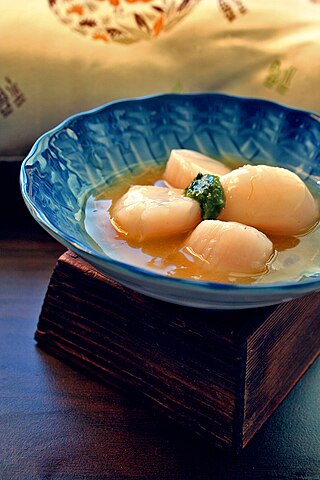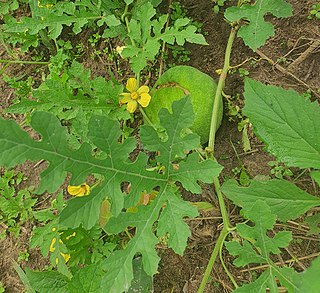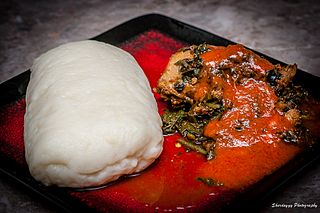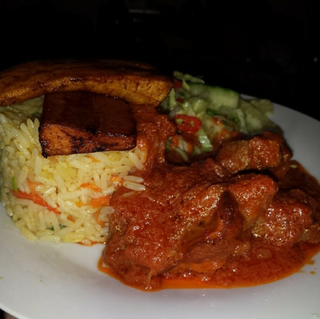
Miso is a traditional Japanese seasoning. It is a thick paste produced by fermenting soybeans with salt and kōji and sometimes rice, barley, seaweed, or other ingredients. It is used for sauces and spreads, pickling vegetables, fish, or meats, and mixing with dashi soup stock to serve as miso soup, a Japanese culinary staple. Miso is high in protein and rich in vitamins and minerals, and it played an important nutritional role in feudal Japan. Miso is still widely used in both traditional and modern cooking in Japan and has been gaining worldwide interest.

Vinegar is an aqueous solution of acetic acid and trace compounds that may include flavorings. Vinegar typically contains from 5% to 18% acetic acid by volume. Usually, the acetic acid is produced by a double fermentation, converting simple sugars to ethanol using yeast and ethanol to acetic acid using acetic acid bacteria. Many types of vinegar are made, depending on source materials. The product is now mainly used in the culinary arts as a flavorful, acidic cooking ingredient or in pickling. Various types are used as condiments or garnishes, including balsamic vinegar and malt vinegar.

Soy sauce is a liquid condiment of Chinese origin, traditionally made from a fermented paste of soybeans, roasted grain, brine, and Aspergillus oryzae or Aspergillus sojae molds. It is recognized for its saltiness and pronounced umami taste.

Conpoy or dried scallop is a type of Cantonese dried seafood product that is made from the adductor muscle of scallops. The smell of conpoy is marine, pungent, and reminiscent of certain salt-cured meats. Its taste is rich in umami due to its high content of various free amino acids, such as glycine, alanine, and glutamic acid. It is also rich in nucleic acids such as inosinic acid, amino acid byproducts such as taurine, and minerals, such as calcium and zinc.

Ẹ̀bà (Yoruba) also known as Ebe or Pinon' is a staple swallow from Nigeria, Togo and Benin, also eaten in the West African sub-region and other African countries. The term èbà originates from Yoruba. It is a cooked starchy vegetable food made from dried grated cassava (manioc) flour commonly known as garri all across West Africa. It is often eaten with rich soups and stews, with beef, stockfish or mutton. The dish is often described as having a slightly sour, sharp taste.

Egusi, also spelled egushi, are the protein-rich seeds of certain cucurbitaceous plants, which, after being dried and ground, are used as a major ingredient in West African cuisine. Egusi is a Yoruba word, and the popular method of cooking it is deeply rooted in Yoruba culinary traditions.

In West Africa, garri is the flour of the fresh starchy cassava root.

Àmàlà is a staple swallow food originating from Nigeria popularized by the Yoruba ethnic group of Southwestern Nigeria and other parts of Yorubaland. It is made of yam, cassava flour, or unripe plantain flour. Tubers of yams are peeled, sliced, cleaned, dried and then ground into flour. It is also called èlùbọ́. Yams are white in colour but turn brown when dried which gives àmàlà its colour. It is a popular side dish served with ewédú and gbẹ̀gìrì, but is also served with a variety of other ọbè(soups), such as ẹ̀fọ́, ilá, and ogbono.

In food processing, fermentation is the conversion of carbohydrates to alcohol or organic acids using microorganisms—yeasts or bacteria—under anaerobic (oxygen-free) conditions. Fermentation usually implies that the action of microorganisms is desired. The science of fermentation is known as zymology or zymurgy.

Fermented bean paste is a category of fermented foods typically made from ground soybeans, which are indigenous to the cuisines of East, South and Southeast Asia. In some cases, such as the production of miso, other varieties of beans, such as broad beans, may also be used.

West African cuisine encompasses a diverse range of foods that are split between its 16 countries. In West Africa, many families grow and raise their own food, and within each there is a division of labor. Indigenous foods consist of a number of plant species and animals, and are important to those whose lifestyle depends on farming and hunting.

Nigerian cuisine consists of dishes or food items from the hundreds of Native African ethnic groups that comprises Nigeria. Like other West African cuisines, it uses spices and herbs with palm oil or groundnut oil to create deeply flavored sauces and soups.

Sake kasu (酒粕) or sake lees is the name given to the pressed lees left over from the production of sake. It is used as a cooking ingredient that is white in color, having a paste-like texture. The taste is fruity and similar to sake itself. A by-product of Japanese sake production, it typically contains 8% alcohol, has high nutritional value, and might have health benefits.

Melothria sphaerocarpa is a species of melon native from southern Mexico and the Dominican Republic through Central America to tropical South America. It has been introduced to western tropical Africa, where has been known under the synonym Cucumeropsis mannii, and is grown for food and as a source of oil, more often for the seed oil than for the fruit.

Corn sauce or fermented corn sauce is produced by fermentation using corn starch as the primary substrate. It is used as a food condiment and ingredient, both in paste and in powder form. Corn sauce, like soy sauce, has a characteristic savory taste. It is used to flavor dishes including soups, broths, and gravies.

Pounded yam is a Nigerian swallow or Okele food. It is traditionally prepared by pounding boiled yam with mortar and pestle. Pounded yam is similar to mashed potatoes but heavier in consistency. It is a smooth and tasty delicacy traditionally eaten with the hands.

Kawal is food made of fermented leaves used as a meat substitute indigenous to western Sudan, in particular the Kordofan and Darfur provinces, and eastern Chad. In urban areas, it is used as a condiment, similarly to black pepper. It is also used by low-income families as a primary protein source, substituting or extending meat or fish in stews and sauces. It is created from the fermented leaves of Cassia obtusifolia, a toxic wild legume also known as the kawal plant.

Obe ata (Yoruba) is a stew or sauce used in Yoruba cuisine and meals found in Nigeria, Benin and Togo. In concept, it is similar to that of French mother sauces: a sauce from which other sauces are made, or to the Mexican Mole. It can be used as the base with which Jollof rice is made, either at the initial or near prepared state. Rice, yam and bread are also eaten with it. In Nigerian cooking the sauce is "ubiquitous".

Yoruba cuisine is the numerous and diverse foods of the Yoruba people of Yorubaland. Some notable Yoruba food include; Ọ̀fadà, Àsáró, Mọ́í Mọ́í, Ẹ̀gúsí soup, Àbùlà, Àkàrà, Ilá Alásèpọ̀, Ẹ̀fọ́ rírò with Ò



















